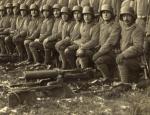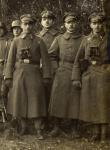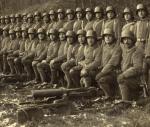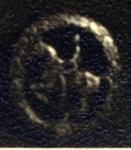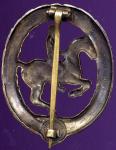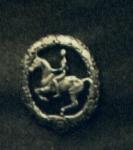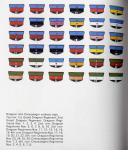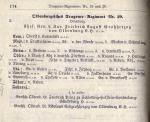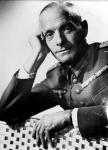-
Posts
4,312 -
Joined
-
Last visited
-
Days Won
4
Content Type
Profiles
Forums
Blogs
Gallery
Events
Store
Everything posted by Naxos
-
Very interesting picture Andy! "Cirkus Breuning" of Sturmbataillon 16 - is what the group calls themselves - perhaps Breuning is the name of the leader, the NCO in the picture. The commander of SB16 was Rittmeister Henke. I will post more info of SB16 tomorrow. Hardy Could you post a close-up of these shoulder-straps
-

Luftwaffe German Uniform?
Naxos replied to TheKnight's topic in Germany: Third Reich: Uniforms, Headwear, Insignia & Equipment
You should google and read a little bit! - Here is a start: http://en.wikipedia.org/wiki/Bundeswehr http://de.wikipedia.org/wiki/Uniform_(Bundeswehr) -

feuerwehr und rettungswesen
Naxos replied to Eric Stahlhut's topic in Germany: Weimar Republic & Deutsche Freikorps
It looks generic (unless the color of the ribbon means something, it could be any of of Austria's 9 provinces ) Most Landesverbände für Feuerwehr und Rettungswesen were established shortly after WWI. -

feuerwehr und rettungswesen
Naxos replied to Eric Stahlhut's topic in Germany: Weimar Republic & Deutsche Freikorps
Eric; It is not German but Austrian Forty year membership in the Austrian Fire and Rescue Service -
The material is not like the pre-war bronze nor is it zinc - besides the needle being longer on one, it is the same set-up right down to the pin holding the needle in place. Left: an early post-war Fahrerabzeichen ---------------------------------------------------------------------------------------- Right: the Reiterabzeichen from post #4 http://gmic.co.uk/uploads/monthly_08_2009/post-1062-125134071551.jpghttp://gmic.co.uk/uploads/monthly_08_2009/post-1062-125134073995.jpg
-
Hi Eric, great to have you here. Regarding the the Reiterabzeichen in #4, it's not the poor details on the back of the badge that bothers me - it's the material it is casted in, as well as the pin set-up that makes me believe it is a post-war production. In that, the badge is identical to early post-war Reiter and Fahrerabzeichen w/o the ®. I do not believe that it is a fake - I believe however, that it may be an early post-war production badge by Steinhauer & Lück (perhaps they made some with and the rest w/o the ®). I will post some comparison shots later.
-

Heer A true Horseman
Naxos replied to Naxos's topic in Germany: Third Reich: Wehrmacht Medals, Decorations & Awards
Absolutly ! Thank you for the input. Have a look at this thread as well: http://gmic.co.uk/index.php?showtopic=15277&view=&hl=reiterabzeichen&fromsearch=1 -

Heer Help with Soldats Unit
Naxos replied to k9mike's topic in Germany: Third Reich: Research, Documentation & Photographs
Inf. Ers. Batl. 119 - see links below http://www.lexikon-der-wehrmacht.de/Gliederungen/InfErsBat/InfErsBat119-R.htm http://www.lexikon-der-wehrmacht.de/Gliederungen/Infanteriedivisionen/25ID.htm -

Bundesrepublik Gen Achim Oster
Naxos replied to dond's topic in Germany: Post 1945: Bundesrepublik & DDR
I compiled a short Bio of Achim Oster (sorry, I can't help you with his awards) Achim Oster (1914-1983) After graduating Gymnasium in 1933, A chim Oster entered as a cadet the Reichswehr. At the beginning of the Second World War he was an aide (Adjutant) at the Artillerieführer des Armeeoberkommandos II. During 1942 and 1943, Oster completed the general staff training course (Generalstabslehrgang). In 1943 he married Anna Haaser. After the German surrender, Oster went into captivity as a Major After the his release he first worked in the center for homeland service (Zentrale für Heimatdienst) and was director of the information and intelligence service (Nachrichtendienst). In 1957 he worked for the German government agencies Schwerin and Blank, which were restructuring of new German Armed Forces (Bundeswehr) . Oster’s assignment was the structuring the military intelligence service. From Mai 1950 until 1957, Oster was in charge of the Sicherheitsgruppe im Amt Blank, the forerunner organization of the German Military Intelligence Service, MAD. After the establishment of the German Federal Armed Forces (Bundeswehr) Lieutenant Colonel Oster became a section chief in the department of armed forces of the Federal Ministry of Defense (Referatsleiter in der Abteilung Streitkräfte des Bundesministeriums der Verteidigung). Then he served as a battalion commander in the 2. Field Artillery Regiment. In 1958, Oster was appointed to Militärattaché at the German Embassy in Spain. He returned in 1964 as a Colonel to the Federal Republic and joined in the staff of the 12. Armored Division (12. Panzerdivision). A short time after, he was promoted to Brigadier General and Assistant Chief of Staff at the NATO headquarters in Fontainebleau. In 1968 he became Deputy Commander of the NATO Defence Colleges. Since 1971 he was as a Major General and Commander of the military district IV. in Mainz. In 1973 Oster went into retirement.





